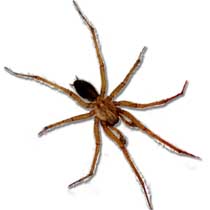Hobo-phobia: Local spider not as aggressive as previously thought
Creepy crawlers are invading Cache Valley homes this Halloween.
The hobo spider, first found in Northern Utah in the early 1990s, has been a pest in many homes, especially during the summer and fall months. Many people are frightened by the poisonous arachnid, which resides in cool, dark areas of homes. The hobo is often referred to as “the aggressive house spider,” which is misleading said Alan Roe, Utah State University Extension entomologist.
“It’s probably a misnomer,” he said, “The common name has been changed to hobo spider, and in my opinion it is less aggressive than certain other spiders.”
Anyone living in a basement area has likely come in contact with a hobo; however the spider is often confused with other types of house spiders, Roe said.
“We can identify them for you, that’s one of my main jobs at the university,” he said.
If an individual captures a spider which he believes to be a hobo spider, Roe said the specimen can be brought to the Plant Pest Diagnostic Lab for research and analysis.
While the spider itself might not be aggressive, individuals should be aware of the spider if it is present and take measures to prevent bites.
“The consequences of the bite are a little more serious than other spiders, or can be at least,” Roe said. “Depending on the person that is bitten, they would experience at minimum, probably a welt, or swelling, or itching.”
He said this occurs in about 50 percent of biting incidents. If necrosis occurs, the skin surrounding the bitten area dies, and takes up to a year to heel.
According to HoboSpiders.com, 50 percent of bites from hobos are “dry,” meaning that no venom is injected, and the victim would probably not notice a bite had occurred.
Death is rarely involved with bites from hobos.
“You can’t really consider it a deadly spider,” Roe said.
A bite from a hobo will typically come as a result of the spider being disturbed. If a spider has resided in bed sheets or a shoe, it will bite, according to HoboSpiders.com.
The best way to keep a house free of hobos is to use preventative measures, Roe said.
“Anything you can do to keep them out of the house, sealing up doors or windows and holes in the wall where insects and spiders can come in,” Roe said. “Insecticides are most effective if you can directly spray the spiders.”
Roe said he recommends using a combination of methods to control hobos. Frequently cleaning behind furniture, under baseboard heaters, inside closets and other undisturbed areas will help control the hobo population within a home.
“Use a vacuum to remove spiders and webs, then place the vacuum bag in the freezer or in a sealable plastic bag and discard,” Roe said. “Remove and destroy any egg sacs that are found.”
Roe also said commercial sticky traps are useful in controlling hobo spiders.
Hobo spider expert Darwin Vest told HoboSpiders.com about the effectiveness of sticky traps.
“Traps are far and away the most safe and effective measure that can be used for controlling hobo spiders indoors,” he said.
No matter which method an individual uses to control a hobo spider problem, everyone should be aware of spiders, and use caution in known infestation areas like wood storage, and cracks in cement, Roe said.
If care is taken to avoid the arachnids, then there is no cause to be afraid of the spider said Mindy Thornley, a junior studying physical education.
“If I have a good solid pair of shoes on, I am not frightened by the,” she said. “However, bare-footed, I am frightened, and it’s all about footwear really.”
Nancy Kerr, a junior in liberal arts and sciences said people should be cautious.
“I watch where I’m walking when I’m barefoot and I check the shower before I get in it, but it’s not a fear,” she said.
Neither Thornley nor Kerr said they had taken significant steps to eliminate hobo populations from their living areas, such as using insecticides.
Kerr, however, had found a very effective natural method to eliminate both spider and insect populations.
She owns a cat that eats the spiders.
“The first time he ate one we were worried that he would get sick, now we encourage him to eat them,” she said. “They’re a delicacy for him.”
Perhaps Kerr found the cure for arachnophobia.
-str@cc.usu.edu

(Photo illustration by Scott Davis)

